Text
Waterless Lithography
WATERLESS LITHOGRAPH PRINT OF A CRUSTACEAN/LOBSTER USING AN EXISTING DRAWING
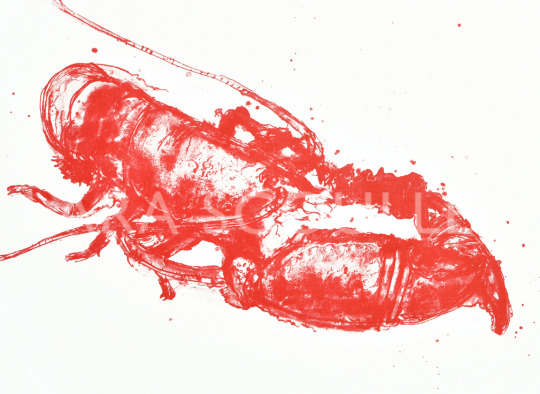
Over the last twelve months I have been getting acquainted with waterless lithography and it’s potential for giving rich results and the ability to produce strong tonal prints. I was lucky enough to spend time working with expert printmaker Mark Hunter on the intricacies of waterless lithography. In this article, I will describe the origins of stone lithography and the relatively more recent developments in waterless lithography, along with exploring the differences between both approaches. I’ll then go on to describe how I applied waterless lithography in my own practice and the most exciting elements I found in the process.
Stone Lithography
Traditional stone lithography was first discovered in 1798 by the German actor and author Alois Senefelder and was used mainly commercially for illustration and reproduction purposes. A flat limestone or metal plate are sponged using water and rolled with an oil-based ink which adheres to the grease loving parts, while the non-image areas are made ink-repellent. Throughout art history, lithography has attracted many fine artists including Toulouse-Lautrec, Bonnard, Edvard Munch, Mary Cassatt and Elisabeth Frink to name but a few. The ability to reproduce rich fluid pencil lines and brush marks has made this technique very appealing to draughtsmen and artists over centuries.
Waterless Lithography
Waterless lithography using printer toner is a fairly recent invention discovered in 1990 by the Canadian printmaker and jeweller, Nik Seminoff. It was created through a desire to develop the process using a variety of easily obtained household materials including non-paintable silicon, acetone and printer toner.
The process in it’s simplest form is based on the ability of silicone to rejecting printing ink. It involves drawing or painting onto an offset aluminium plate using toner or a water-soluble pencil and bonding the image to the plate using heat. A thin layer of silicone solution is then applied to create a non-printable area. The plate is left to cure overnight and the toner is washed out using acetone, leaving a ghost like image which can then be inked up using rubber ink and a brayer. The plate is then ready for printing using an etching press or by hand.
What’s the difference?
Waterless Lithography is less labour intensive, using safer less-toxic materials than traditional stone lithography. Whilst maintaining many of the desirable characteristics such as fluidity of line, washes, gradation in tone, textures and reticulation.
Unlike traditional stone lithography, the aluminium plate is light and can be easily transported to any location such as a museum or working outdoors 'en plein air', etc. Until the surface has been bonded to the plate it is very fragile and needs to be transported with care.
The Process
Referring to sketchbooks is a great way to find inspiration in the studio and allows you to play around with composition and colour and revisit unresolved ideas.
My Red Lobster print was inspired by a previous drawing I made on location from a fishing harbour in the East Neuk of Fife, Scotland. Here is how I made it.
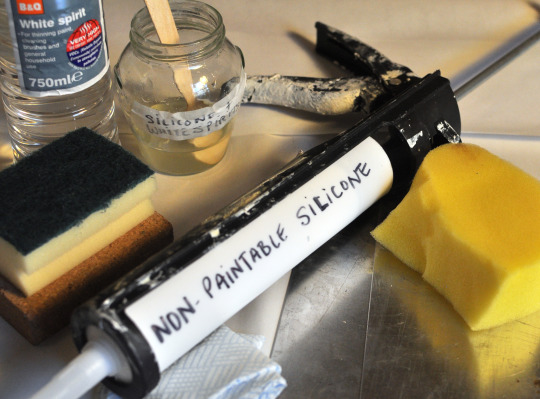
1
The initial drawing was made directly onto a prepared aluminium plate which has been degreased and treated with sodium metasilicate which helps to bond the silicone to the plate added later in the process. It is important to dry the plate quickly as any streaks left from the sodium could impair the finished print.

2
Once the plate is dry it is ready for the toner solution to be applied. You can use many easily sourced implements to apply the toner including paintbrushes, lollipop sticks, sponges, even a toothbrush can create great splatters and specs. The surface of the plate is easily manipulated and can be washed clean with a damp sponge if you are unhappy with the results. Special pencils called Lumocolor by Staedtler create fantastic fluid lines with subtle gradation in tone when applied with a light touch.
A Sharpie pen can also be used to create solid lines/areas of colour. Rich velvety tones are made using concentrated washes of toner, while reticulation (grain pattern) can be achieved by adding more water to the toner.
I used large paint brushes and applied a concentrated mix of the toner solution to the plate to create the velvety black areas. After it has air dried I worked back into the plate using a lollipop stick to pick out some of the subtle details to the lobster shell. A soluble pencil was used with a wash of water to create the linear shape of the antennas.
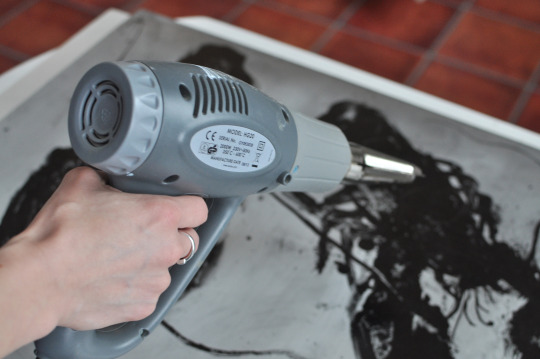
3
Once happy with the results, a heat gun is applied to bond the image to the plate and will become glossy when fixed. At this point there is still the opportunity to add to the image if desired, but be sure to heat the plate again if so.
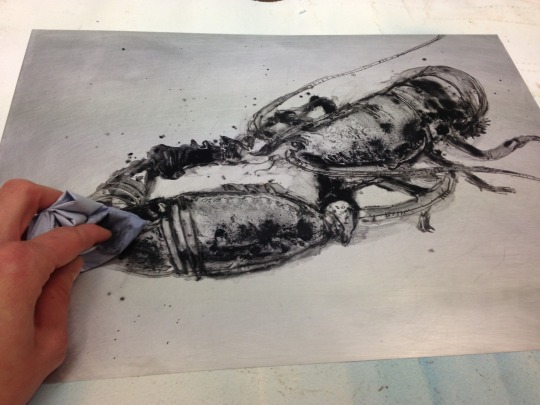
4
A solution of non-paintable silicone and white spirit is mixed to the consistency of runny honey and is spread onto the plate using a tissue, the aim is to cover the whole plate creating a thin film of silicone. Once you are happy that the plate has been evenly covered, buff the surface using a tissue wrapped in a firm sponge. The plate should be left overnight to cure in a well ventilated room. It is important when working with solvents and chemicals to keep the room well ventilated and wear gloves and protective eye wear.
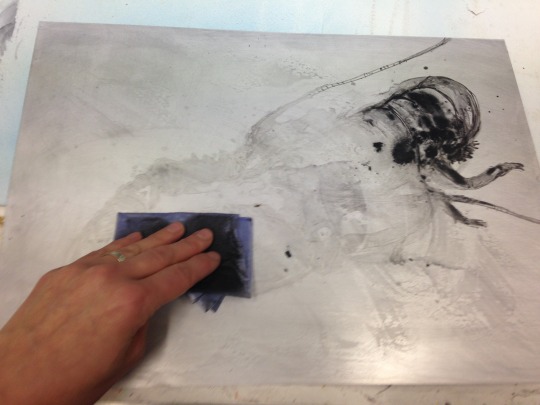
5
The plate is now ready to be washed out using a tissue and acetone, it is important to keep the tissue well soiled as any abrasive material may affect the delicate surface of the plate. Allow the acetone to do all the work. A ghost image will appear and won’t be fully visible until the plate is inked up.
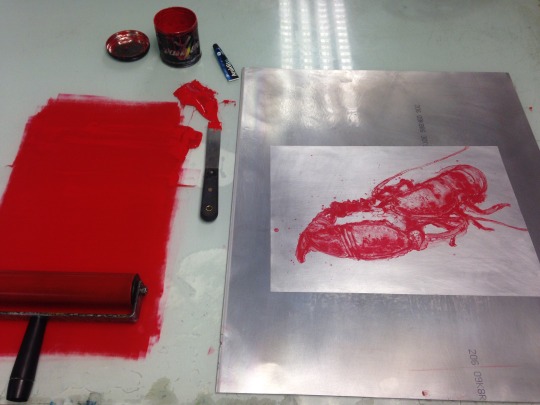
6
Use a rubber based ink such as Van Son Holland. Drag and scrape the ink to create a bead at the top of your workstation unit. A sub-plate is placed under the printing plate which has been coated with silicone to reject the ink from the brayer (roller) when it goes over the edge of the plate.
Once you have inked up the brayer onto your glass plate, roll your brayer onto a corner of the silicone plate to test if it rejects the ink. If it does reject the ink then you are ready to ink up the plate.
It is a good idea to change direction of the brayer to achieve maximum coverage of the image, using a snapping action with the brayer to clean off any unwanted ink on the plate.
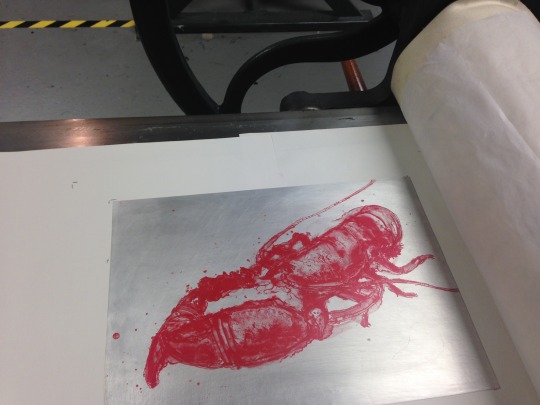
7
With the plate inked, we are ready to print. Smooth paper will produce the best results with this method, such as Zerkal and Fabriano 5. It is always a good idea to make a couple of test prints onto newsprint first to gauge how much ink and pressure you should apply.
The application of waterless lithography has allowed me to retain an expressive painterly feel in my work. I would recommend it to anyone wishing to develop their printmaking skills.
#waterlesslithography#printmaking#dcadundee#Artist#lithographymethod#lightography#art#printingtechniques
2 notes
·
View notes
Photo



I was recently asked to write an article about waterless lithography, you can read the full article here.
1 note
·
View note
Photo

Caught on camera painting the beautiful great white pelicans at Edinburgh Zoo.
I love the way pelicans change their form from a compact solid shape with their heads held close to their body to stretching their necks creating an elegant s shape. It’s a beautiful thing to witness and draw.
1 note
·
View note
Photo


My Kestrel screen print was inspired by a pastel drawing I made from the Perth Museum Collection, Perth. The screen print was made at the DCA Print Studio in Dundee and is now on show at the Tower Foyer Gallery, University of Dundee, Scotland.
#kestrel#pasteldrawing#screenprint#birdprint#bird#birdofprey#art#scottishart#DCAdundee#pastel#unisonpastels#universityofdundee#DJCAD#UOD#Scotland#taxidermy#artist#drawing
1 note
·
View note
Photo


Really pleased with how my proof printing went today. Looking forward to printing the final Penguins tomorrow
0 notes
Photo


Blue Cormorant
This is my latest cormorant screen print, inspired by a pastel drawing I made a few years ago. I really enjoy revisiting drawings through printmaking, it allows me to be a bit more experimental with colour and composition. With this particular screen print I have used washes of tusche on Folex - foladraft to create a positive image. The tusche can be diluted with water to create gradated washes, once dry it is possible to scratch into the surface to bring out finer detail such as feathers.
Please visit my Print Shop where you can see further examples of my work.
0 notes
Photo


Gull in flight
Since attending the John Busby Seabird Drawing Course earlier this year I have become more attuned to my surroundings and the birds that inhabit it. In my latest series of screen prints and pastel drawings I have been exploring birds in flight. This particular gull was inspired by the drawing course trip to Fidra, a small island in the Firth of Forth and visits to the McManus Gallery in Dundee.
1 note
·
View note
Photo



Award-winning graduate artist launches first solo Dundee show
A new exhibition of drawings and screenprints by award-winning wildlife artist Lara Scouller opens in the University of Dundee’s Tower Foyer gallery tomorrow.
Lara graduated with a fine art degree from the University’s Duncan of Jordanstone College of Art & Design in 2006 and has since held exhibitions across the UK. However, this new show, ‘AVEM: a journey with birds’, is her first solo exhibition in Dundee, where she still lives and works.
The exhibition features a selection of recent work inspired by her time on the John Busby Seabird Drawing Course earlier this year.
Lara is well-known for her studies of animals in museum collections such as the University’s D’Arcy Thompson Zoology Museum and the Bell Pettigrew Museum in St Andrews. Recently she has been drawn to studying birds and their surrounding landscape.
She said, “I like to be immersed in the birds’ natural habitat, bringing me closer to their lives. The work shown in this exhibition marks a new phase in my work as an artist.”
Curator Matthew Jarron added, “We’re delighted to be showing Lara’s work at the University. I’ve been a great admirer of her drawings since she was a student here – she has an exceptional ability to capture the essence of a particular animal in just a few lines of pastel.”
Lara has won numerous awards for her drawings including The James Torrance Memorial Award and The Pastel Society Young Artist Award. Her work can also be found in many museum and private collections.
The exhibition runs from Saturday, 5th December until 13th February and is open from 9.30am-7pm on weekdays and from 1-5pm on Saturdays. The gallery will be closed for Christmas from 24th December to 3rd January.
Article written by Grant Hill Press Officer University of Dundee
#avem#birds#Cormorant#toucan#gannet#taxidermy#still#larascouller#artist#dundee#fife#st.andrews#standrews#seabirddrawingcourse#exhibitiondundee#screenprints#printmaking#drawing#guillemot
3 notes
·
View notes
Photo



Cormorant
Screen print
The cormorant is a powerful bird in flight and a strong swimmer under water. It is also a recurring theme in my work. I have new orange and yellow cormorant screen prints available to buy from my online print shop.
0 notes
Photo


A siege of herons
The Grey Heron is my latest screen print made this week at the DCA Print Studio. I’ve been experimenting with tusche and cut paper to create this three layer colour print.
3 notes
·
View notes
Photo






John Busby Seabird Drawing Course 2015
I was recently awarded the Seabird Drawing Course bursary by the SWLA allowing me to attend the John Busby Seabird Drawing Course in July this year.
The week of activities entailed field drawing at specific seabird colonies, drawing exercises lead by acclaimed artists Kittie Jones, Greg Poole, John Threlfall and Darren Woodhead who all provided excellent guidance and inspiration. Participating in the course allowed me to try new approaches, develop a new body of work and make connections with people working in similar areas.
#Johnbusbyseabirddrawingcourse#Cormorant#gull#puffin#stabbshead#kilspindie#bassrock#fidra#Gannet#drawing#pastel drawing#sketchbook#artist#seabirds
2 notes
·
View notes
Photo




Cormorant screen print using tusche
I really enjoy working with tusche - similar to ink it can be mixed with water and applied in washes to create a painterly effect. The tusche is painted directly onto Folex foladraft - a drafting and diffusion film - which will then be taped onto a prepared silk screen ready to be exposed.
1 note
·
View note
Photo




A selection of sketchbook drawings from a weekend spent at Dumfries House. The autumnal colours and tree structures provided a great source of inspiration. I will definitely go back and bring more sketchbooks next time!
#trees#sketchbook#Dumfrieshouse#Ayrshire#sketchbooks#artist#redwoods#river#pastel#unison#larascouller
2 notes
·
View notes
Photo


A is for Aardvark
Aardvark, 64 x 48 cm, screen print edition of 10
My aardvark screen print was made from an original monochromatic charcoal drawing, inspired by a recent trip to the Dead Zoo Natural History Museum in Dublin.
I now have an online print shop where you can buy my original prints.
0 notes
Photo


C is for Crocodile
I’ve been enjoying developing my drawings into screen prints using a mixture of cut paper and tusche. It’s allowed me to add colour and experiment with composition. I think the green brings this charming crocodile to life. Snap Snap...
My original screen prints are now available to buy online. Please visit my shop for more examples of my prints
#screenprint#hippo#crocodile#dundee#DCA#artist#Scottish#Larascouller#peafowl#blackbird#animals#art#printmaking
0 notes
Photo
Really proud of my sister, she recently had here self portrait (top left) included in the Royal Society of Portrait Painters exhibition.
www.kimscouller.com

Royal Society of Portrait Painters
My self portrait is now on show at the Mall Galleries RSPP exhibition until the 1st of May 2015. Some cracking portraits including work by Ilaria Rosselli del Turco and David Maiden (pictured above).
2 notes
·
View notes
Photo








I’m really excited about my first solo exhibition in Edinburgh at the Open Eye Gallery. You can view all the works in the exhibition here.
2 notes
·
View notes